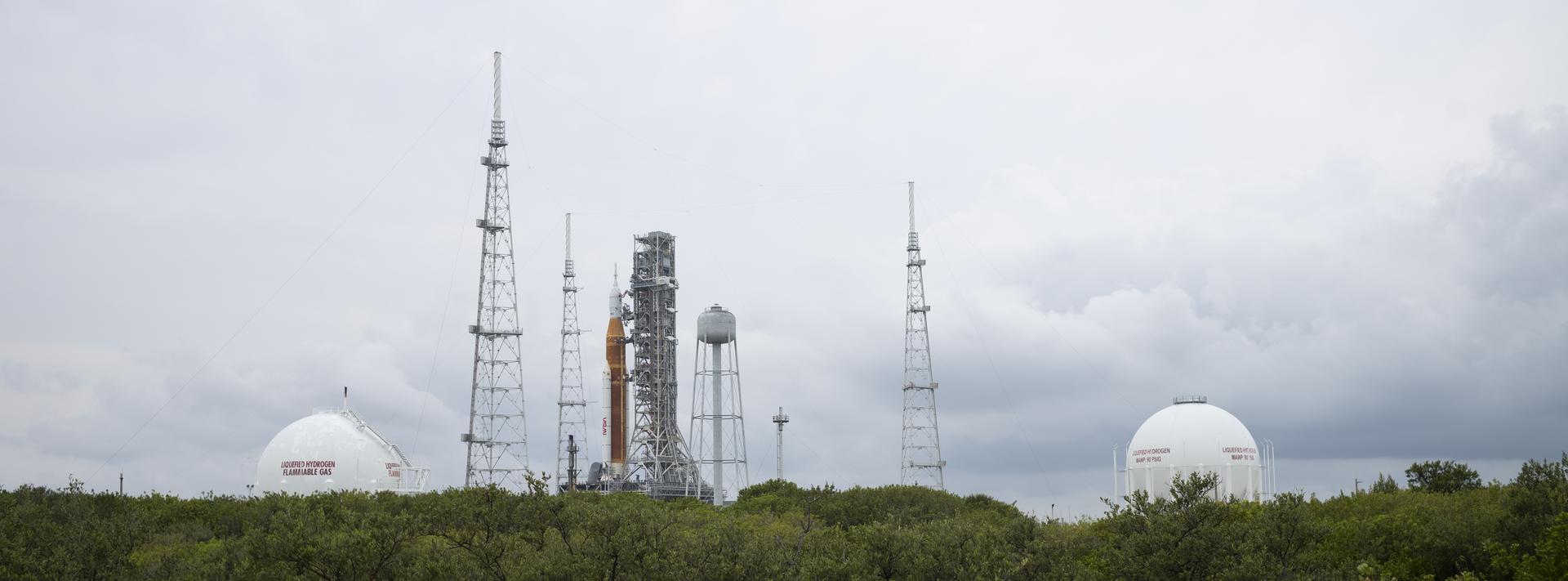
HOUSTON—NASA will aim for early April 4 to resume the Artemis I Wet Dress Rehearsal (WDR), a critical Kennedy Space Center launch pad countdown simulation for the mission’s Space Launch System (SLS) rocket and Orion crew capsule.
The April 3 WDR was scrubbed in response to a loss of capability to sufficiently pressurize the Mobile Launch Platform (MLP), upon which the 322-ft. tall, 5.75 million-lb. rocket rests.
A malfunction of the primary and backup fans adjacent to the two-story, just over 21,000-ft.2 MLP prevented an assured positive pressure within enclosed portions of the structure that are needed to keep out hazardous gases prior to fueling the rocket so that ground support system personnel may safely proceed with the loading of low temperature liquid oxygen and hydrogen propellants into the SLS core and Interim Cryogenic Propulsion upper stages.
With favorable weather anticipated, troubleshooting of the fans was to be completed overnight. WDR activities in the launch control center were to resume on April 4 at 7 a.m. EDT, with the propellant loading preparations and actual loading to follow, leading to a planned culmination of the WDR at 2:20 p.m. EDT, Charlie Blackwell Thompson, NASA’s Exploration Ground Systems Artemis launch director, said during a post-scrub news briefing.
A further unplanned interruption could lead to a lengthy WDR delay, as NASA prepares for a pair of launches to the International Space Station from Kennedy. Those include the 10-day Axiom Space AX-I private astronaut mission planned for a midday April 6 liftoff, and NASA’s SpaceX Crew 4 Dragon mission to the ISS planned for early April 20, with four NASA and European Space Agency astronauts as part of a crew exchange, according to Blackwell Thompson.
“We are learning about the vehicle. The team is prepared for this. We just need to get through the technical issues,” Mike Sarafin, NASA’s Artemis mission manager, said. “They have demonstrated incredible discipline and toughness. I’m confident we will get there soon.”
The count was stopped April 3, a little more than six hours after Charlie Blackwell-Thompson, the NASA launch director, and the Mission Management Team gave a “go” at 6:45 a.m. EDT, to proceed with tanking operations starting at 7:20 a.m. EDT, which ultimately were to lead to loading of the SLS core and upper stages with 730,000 lb. of the two cryogenic propellants. The WDR outcome will set the stage for the Artemis I launch, a multi-week test flight of an uncrewed Orion capsule around the Moon and back to Earth for a Pacific Ocean splashdown and recovery.
Artemis II is to follow, with a test flight with four Orion crew around the Moon and back to Earth, possibly in 2024. Artemis III would come next, the first post-Apollo landing of two astronauts on the lunar surface at the unexplored south pole for an estimated weeklong stay and return to Earth, possibly in 2025.
Ultimately, NASA intents to work with international and commercial partners for the launch of crewed Artemis missions to the Moon on an annual cadence to explore, establish a permanent human presence and prepare for human expeditions to Mars.
The Artemis I SLS and Orion departed Kennedy’s Vehicle Assembly Building (VAB) atop the MLP for launch pad 39B on and the milestone countdown simulation on March 17.
The call to stations for those participating in the test at KSC’s Launch Control Center and the launch pad occurred as planned on April 1 at 5 p.m. EDT, with plans to target a two-hour test window that was to open on April 3 at 2:40 p.m. EDT. The WDR was to countdown to a 10-min. hold, then proceed to 33 seconds before what would be the liftoff for an actual mission. The simulation calls for the count to then be recycled to the 10-min. hold point and resume to just under the 10 second point prior to an actual launch to conclude the simulation.
“We would like to demonstrate that capability to get into terminal count, to recycle to validate our timelines for how long it takes to get back from a terminal count run No. 1 to a terminal count run No. 2 and demonstrate the ability to do that within a two-hour launch window, explained Blackwell-Thompson. “We’ve trained in a simulator, but we would really like to do that with the flight hardware.”
April 2, the second day of the three-day WDR, produced some suspense as well in the form of several lightning strikes within the launch pad’s perimeter, three judged low intensity and striking the same lightning protection tower and one strike of higher intensity at a separate lighting protection tower.
The strikes accompanied heavy rains and high winds. All occurred while the SLS first stage and the Orion were powered up, slowing scheduled procedures by about four hours, according to Blackwell Thompson. Eventually, it was decided the fan issues were not related to the lighting strikes.
Early April 3, an assessment by the launch control and mission management teams decided conditions were acceptable to proceed, according to Sarafin.
Once the terminal count portion of the simulation concludes, the SLS and its upper stage will be drained of propellants. The MLP is to roll the SLS and Orion hardware back to the VAB for an assessment of the hardware and equipment.





